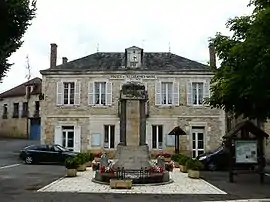Sainte-Orse
Sainte-Orse is a commune in the Dordogne department in Nouvelle-Aquitaine in southwestern France. The church of Saint Ursus (Saint Ours) dates from the 11th-12th century. The castle dates from the 15th-16th century.
Sainte-Orse | |
|---|---|
 Post office and town hall | |
Location of Sainte-Orse 
| |
 Sainte-Orse  Sainte-Orse | |
| Coordinates: 45°12′16″N 1°04′35″E | |
| Country | France |
| Region | Nouvelle-Aquitaine |
| Department | Dordogne |
| Arrondissement | Sarlat-la-Canéda |
| Canton | Haut-Périgord Noir |
| Government | |
| • Mayor (2008–2014) | Camille Géraud |
| Area 1 | 23.54 km2 (9.09 sq mi) |
| Population (2017-01-01)[1] | 358 |
| • Density | 15/km2 (39/sq mi) |
| Time zone | UTC+01:00 (CET) |
| • Summer (DST) | UTC+02:00 (CEST) |
| INSEE/Postal code | 24473 /24210 |
| Elevation | 163–292 m (535–958 ft) (avg. 231 m or 758 ft) |
| 1 French Land Register data, which excludes lakes, ponds, glaciers > 1 km2 (0.386 sq mi or 247 acres) and river estuaries. | |
Population
| Year | Pop. | ±% |
|---|---|---|
| 1962 | 445 | — |
| 1968 | 486 | +9.2% |
| 1975 | 460 | −5.3% |
| 1982 | 404 | −12.2% |
| 1990 | 372 | −7.9% |
| 1999 | 358 | −3.8% |
| 2008 | 375 | +4.7% |
Village history
The first written reference of the town is the village church, "Sancta Ursa" recorded in the year 1072.[2] The "Cassini map" of France between 1756 and 1789, shows the village under the name of "'Saint Orse"', and during the revolutionary period of the National Convention (1792-1795), the name was "'Orse-le-stony".[3]
Landmarks
A number of historic buildings are located in the town:
- Church of Saint-Ours, 11th or 12th century Romanesque Church with a 19th-century bell tower. It is listed as a historical monument since 1970.[4]
- Several Merovingian sarcophagi.[5]
- The Church also preserves a relic of Pope John Paul II (a piece of the belt of the former Pontiff).
- Château de Sainte-Orse, 15th and 16th centuries.[6]
- La Salle gentilhommiere, 18th century, today a school.
- 18th century Manor of La Faye.
- Château de Laudonie Den of Peyre-brune.
See also
References
- "Populations légales 2017". INSEE. Retrieved 6 January 2020.
- Chantal Tanet and Tristan Hordé, "Dictionary of the place names of the Périgord", (Fanlac, 2000), p.381.
- Notice Comunale.
- http://www.culture.gouv.fr/public/mistral/merimee_fr?ACTION=CHERCHER&FIELD_1=REF&VALUE_1=PA00082882 Monuments historiques] entry at French Ministry of Culture.
- Monuments historiques ministère français de la Culture.
- Guy Penaud, Dictionnaire des châteaux du Périgord (Sud Ouest, 1996) p. 255.
| Wikimedia Commons has media related to Sainte-Orse. |
This article is issued from Wikipedia. The text is licensed under Creative Commons - Attribution - Sharealike. Additional terms may apply for the media files.